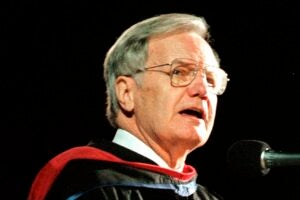AUSTIN, Texas—As Texas’ electric grid operator prepares to add power lines for carrying future wind-generated energy, an electrical engineer at The University of Texas at Austin is developing improved methods for determining the extent to which power from a wind farm can displace a conventional power plant, and how best to regulate varying wind power.

|
|
Dr. Surya Santoso stands in front of a photograph of a Siemens wind turbine at King Mountain Wind Ranch in McCamey, Texas. These towers can measure up to 68 meters in height, with blades as long as 30 meters, generating one to two megawatts (million watts) of power. |
|
Photo: Erin McCarley |
“The cost of wind energy has become competitive with that of energy from fossil fuels because of technology improvements,” said Assistant Professor Surya Santoso. “Unfortunately, electric power generated from wind energy is intermittent and variable. That means we need to have better measurements of wind power plants’ output as we integrate wind energy into existing power systems. We also need to develop a way of managing wind power so it can be more readily called upon when needed.”
Texas has outstripped California since 2006 as the leading national producer of wind power, with most of the state’s renewable energy goal by 2025 focused on wind power. To help meet this goal, the state’s Electric Reliability Council of Texas is expected to add about 1,500 megawatts of new wind generation this year alone. In late September, Texas also awarded four offshore tracts along the Gulf Coast for wind power projects with a generating capacity of 1,150 megawatts.
Santoso is developing two strategies to manage and overcome the intermittent and variable behavior of wind power. With a two-year, $200,000 grant from the National Science Foundation, he and his students are developing computational methods to measure the actual capacity contribution of wind farms. This will allow system planners to calculate how much a wind farm can contribute to meeting expected power needs.
Santoso’s lab is also using the funding to establish the technical requirements of energy storage systems that would serve as temporary “batteries” for releasing stored wind energy at optimal times.
“Having a proper energy storage system would allow you to harness free wind when it’s available, but release that energy at the time of your choosing with a desired power profile,” Santoso said. He noted that a wind energy storage system would also increase wind farms’ overall capacity contribution and reduce the likelihood of overloading transmission power lines that must carry energy from different power sources.
For more information contact: Barbra Rodriguez, Cockrell School of Engineering, 412-471-7541.



